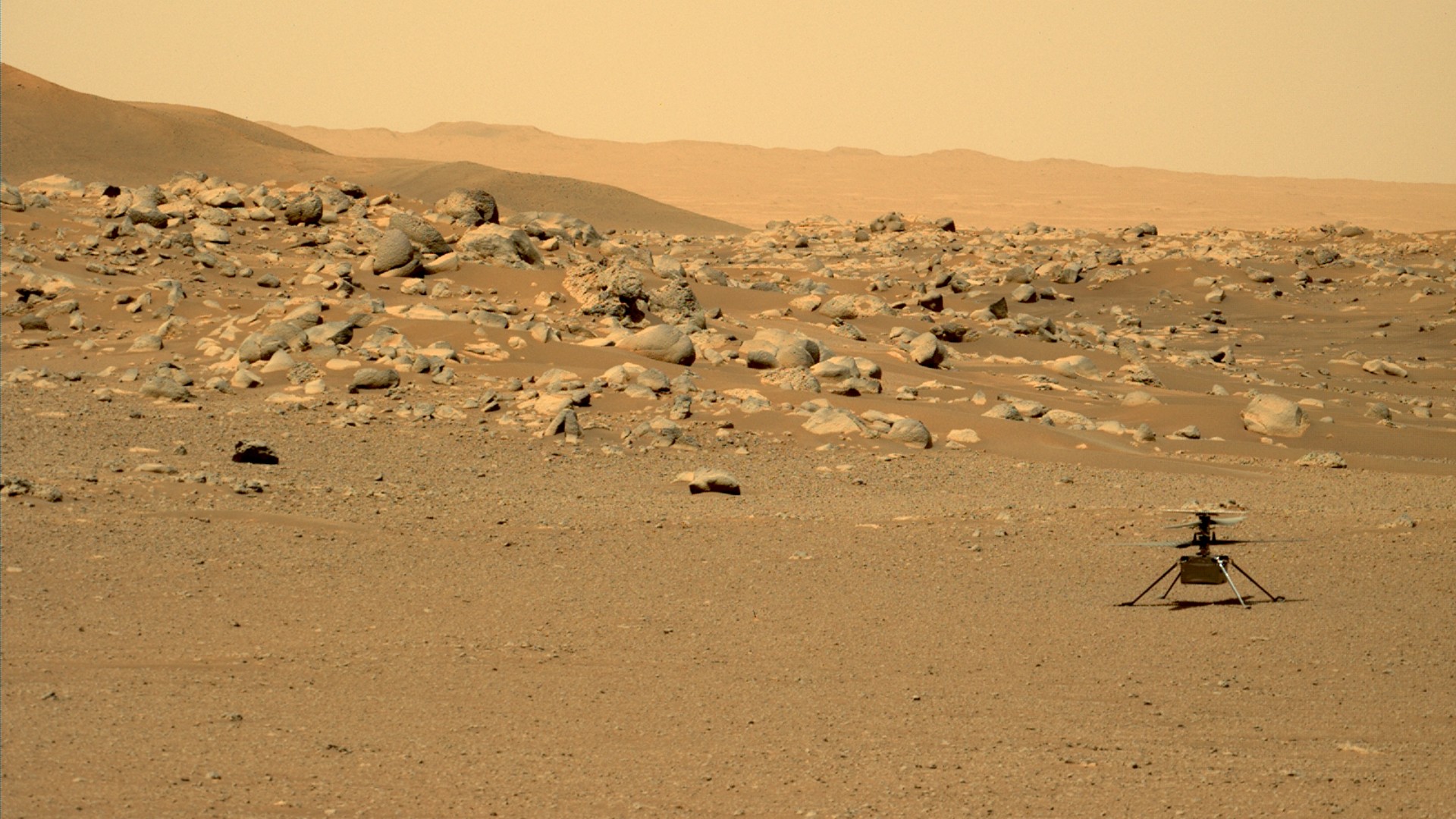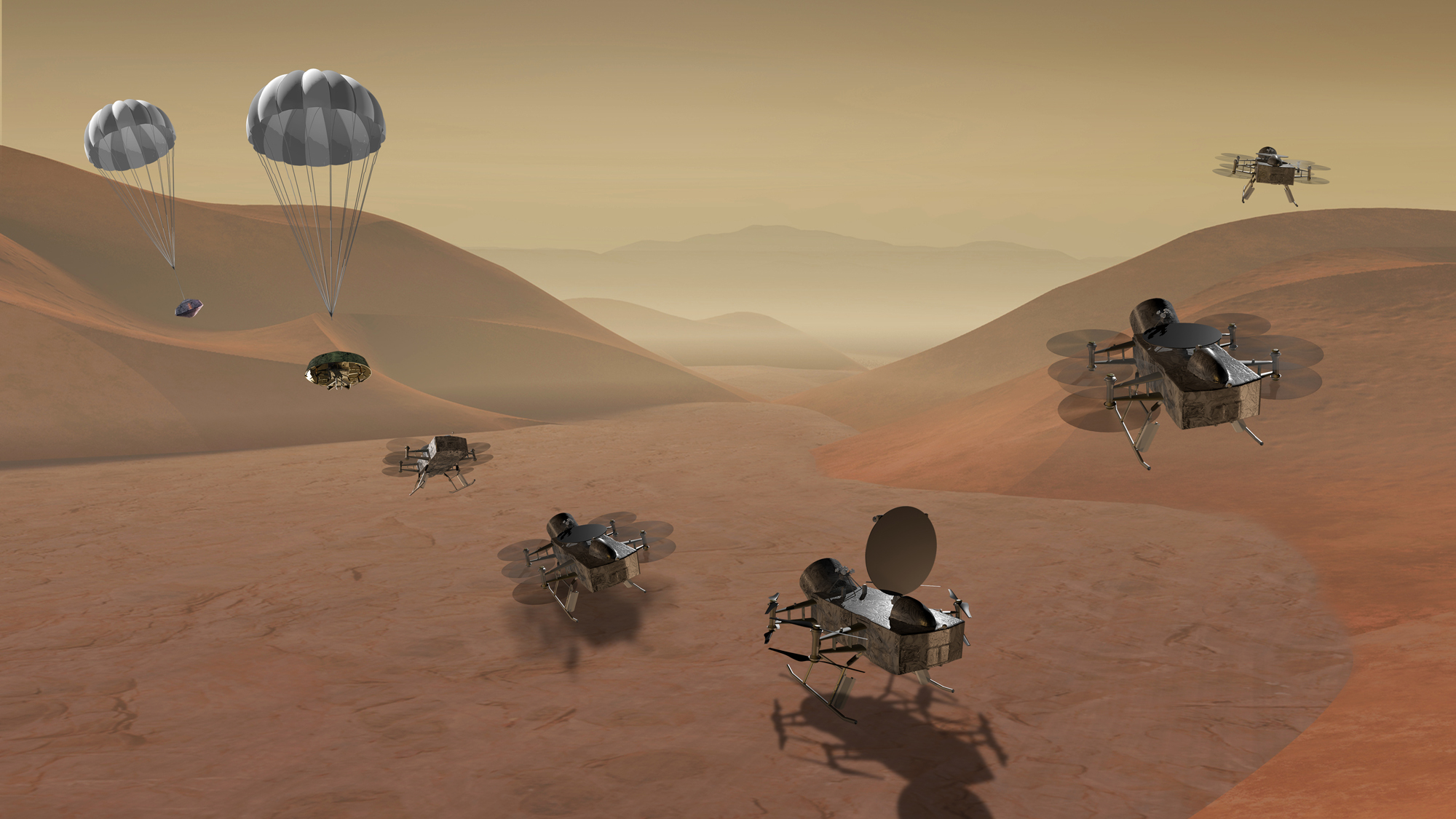Space helicopters will help us explore Mars and other worlds. Here's how.
In the wake of the success of Mars' Ingenuity helicopter, more space aircraft are coming.

When NASA scientists were planning the Mars Perseverance mission, they decided to try something new: Instead of just sending a rover, they'd also send up a small helicopter. Although originally intended as a simple technology demonstration, the aircraft Ingenuity has far exceeded expectations.
"It did such a good job in fact that even though we originally were meant to fly only up to five times on Mars, we got a new mission," Håvard Grip, an engineer at NASA's Jet Propulsion Laboratory (JPL) in California who is the aerodynamics and flight control lead and the chief pilot for the Ingenuity helicopter, said during a news conference during the American Geophysical Union Fall Meeting being held this week in Chicago and virtually. Ingenuity would now help scout ahead for the Perseverance rover, scoping out the landscape from the air.
In fact, Ingenuity has been so successful that scientists are already gearing up to use successor helicopters to explore Mars and beyond, including how future helicopters could further explore and even sample the Martian environment and how NASA's Dragonfly mission to Saturn's moon Titan will utilize a helicopter to help us study an entirely different world.
Related: 12 amazing photos from the Perseverance rover's 1st year on Mars
Although its first flight was a demonstration that lasted only 39 seconds, Ingenuity has now not only scouted for Perseverance, but also taken detailed photographs of a Martian outcrop, helping scientists to create a 3D model to study the area. It also photographed Perseverance's landing equipment to give engineers a valuable look at their work on the equipment after it had been used.
During the briefing, Grip described how Ingenuity team members made a pilot's logbook for the helicopter before landing on Mars and added lots of extra pages because they thought a five-page logbook would look silly.
"But guess what? We are out of pages," he said, holding up the book. "As of two days ago, Ingenuity made its 36th flight, and there are 36 pages in here."
Get the Space.com Newsletter
Breaking space news, the latest updates on rocket launches, skywatching events and more!
NASA scientists are aiming to build on Ingenuity's success by developing an aircraft that can collect sample tubes from the Martian surface. This Mars Sample Return Sample Recovery Helicopter would be based on Ingenuity's design but would boast wheels for navigating on the ground, as well as a robotic arm.
The upgrades would allow two of the new helicopters to collect sample tubes, serving as a backup for Perseverance, which is meant to deliver the tubes to the sample-return lander, said Teddy Tzanetos, who is an engineer at JPL, the engineering team lead for Ingenuity and the manager for the new sample recovery helicopters mission, during the briefing.
"We are largely leveraging all of the amazing lessons learned — that we have learned and will continue to learn with ingenuity over the last year and a half," he said.

Mars isn't the only world NASA will explore with an aircraft. NASA's Dragonfly mission, currently scheduled for a 2027 launch, will use a rotorcraft to explore Saturn's icy moon Titan. The only moon in the solar system with an atmosphere, Titan is ideal for aerial exploration: because it has a weaker gravity and half again the atmospheric pressure of Earth, Titan is an extremely easy place to fly. In fact, it's so much easier to fly on Titan than Mars that Dragonfly is about the size of the Perseverance rover — like a small SUV. In contrast, Ingenuity is only about 1.6 feet (0.5 meters) tall and 6 inches (15 centimeters) wide (not counting its blades), closer to the size of small remote-controlled drones on Earth.
Scientists want to visit Titan for several reasons, Elizabeth Turtle, a planetary scientist at the Johns Hopkins Applied Physics Laboratory in Maryland and the principal investigator for the Dragonfly mission, said during the news conference. Not only does Titan have a water-ice crust and seas of liquid methane reminiscent of water on Earth, Turtle said, it also has abundant carbon-rich chemistry, like that found in life on Earth.
Studying Titan will give scientists a look at this familiar chemistry in a totally different context, enabling them to study whether certain conditions are habitable and might have led to life. To do this, Dragonfly will be equipped with scientific instruments including spectrometers, a drill for collecting samples, geophysics and meteorology sensors and a camera.
"Fundamentally, Dragonfly is a chemistry mission," Turtle said. "Titan has been doing the kind of chemistry experiments we can't do here on Earth, because we don't have millions of years in the laboratory to do them. So Titan has been doing these for us, and Dragonfly is designed to pick up the results of those experiments."
In the future, aircraft could play other import roles for planetary exploration. Helicopters could take samples from areas without leaving the sort of track marks and disturbances that a rover would, which could be especially important in areas scientists call "biologically sensitive." NASA scientists are also developing a design for a future Mars Science Helicopter, which like Dragonfly would be the size of Perseverance and would be able to carry heavier samples and scientific instruments.
"My personal dream is one day we'll have astronauts at Mars and there'll be fleets of vehicles zipping around helping the first humans there with simple and complicated tasks," Tzanetos said. "But it all started with that first 39-second flight that we did about a year and a half ago."
Follow us on Twitter @Spacedotcom and on Facebook.
Join our Space Forums to keep talking space on the latest missions, night sky and more! And if you have a news tip, correction or comment, let us know at: community@space.com.

Rebecca Sohn is a freelance science writer. She writes about a variety of science, health and environmental topics, and is particularly interested in how science impacts people's lives. She has been an intern at CalMatters and STAT, as well as a science fellow at Mashable. Rebecca, a native of the Boston area, studied English literature and minored in music at Skidmore College in Upstate New York and later studied science journalism at New York University.
